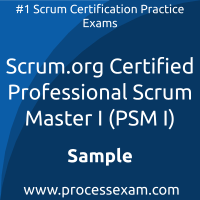01. During a Sprint, when new tasks or information to reach the Sprint Goal is identified, when can new work be added to the Sprint Backlog?
Choose the best answer.
a) As soon as it’s known.
b) After it’s been reviewed and approved by the Scrum Master.
c) When it’s discussed in the Sprint Planning.
d) During the Daily Scrum.
02. Which of these statements best describes what happens during Sprint Review?
Choose the best answer.
a) While going through the Increment, the Sprint Review is also good place to discuss individual team member’s performance.
b) The Scrum Team prepares presentation deck for the stakeholders.
c) The stakeholders schedules high-priority improvements to be made next Sprint.
d) The Scrum Team and stakeholders review the Increment, and collaborate on future adjustments.
03. How much time does a Scrum Team have after a Sprint, to prepare for next Sprint?
Choose the best answer.
a) Up to 10% of the Sprint’s duration.
b) As much as it needs to refine the Product Backlog item.
c) None. A new Sprint starts immediately after the end of the previous Sprint.
d) Up to eight hours for a one-month Sprint. For shorter Sprint, it’s usually shorter
04. If a Scrum Team wants to capture non-functional requirements, what is a good way to do it?
Choose the best answer.
a) Trust that the Developers would know what to do and automatically add the feature to the Increment.
b) Add them into the Product Backlog to be considered for development.
c) Create a seperate list of non-functional requirements, and include it in the Sprint Backlog.
d) The Developers actively remind each other in the Daily Scrum.
05. What does a Scrum Master do during Sprint Retrospective?
Choose the best answer.
a) Take notes of all the team’s challenges and pass them on to Management.
b) Lead the discussion.
c) Summarise the team’s performance from last Sprint
d) Actively facilitate as needed, and also participate in the event as a team member.
06. Burndown charts are used to show a Sprint’s progress visually. What information does the chart show?
Choose the best answer.
a) The total cost spent for product development.
b) How many Product Backlog items have each team member completed.
c) Remaining work within the duration Sprint.
d) The number of product features completed.
07. When can a Product Backlog item be considered complete?
Choose the best answer.
a) When it meets the Definition of Done.
b) At the end of the Sprint.
c) When all code changes are done with more than 95% testing complete.
d) When the Product Owner and Stakeholders approve the feature in Sprint Review
08. During Sprint Retrospective, the Scrum Team discovers a few important process improvements. What needs to happen in this situation?
Choose the best answer.
a) There should be no change to any processes when everything runs just fine.
b) The Scrum Master picks the most relevant improvement for the team to apply next Sprint.
c) The team adds all improvements to the Sprint Backlog.
d) The improvements may be added to the Sprint Backlog to be addressed next Sprint.
09. When multiple Scrum Teams are working from the same Product Backlog, how should they choose the Product Backlog items to work on?
Choose the best answer.
a) Each Scrum Team should maintain their own Product Backlog.
b) The most important items should be worked on by the best team.
c) The Developers in each team choose the items based on a discussion with the Product Owner.
d) To reduce complexity, the Product Owner allocates items to the teams.
10. In a Sprint Planning, how much work should the Scrum Team prepare?
Choose the best answer.
a) Enough work so the team understands the main goal committed for the Sprint, the items they will work on, and a plan to develop the items.
b) Just enough so everyone understands the system’s architecture.
c) Everything about the Product Backlog items have to be 100% prepared and refined with detailed documentation on how to build each item.
d) As much as the Product Owner needs to explain the Product Backlog to the team.
 You have to pass the PSM I exam to receive the certification from Scrum.org. To increase the effectiveness of your study and make you familiar with the actual exam pattern, we have prepared this Scrum.org Professional Scrum Master sample questions. Our Sample Scrum.org Professional Scrum Master I Practice Exam will give you more insight about both the type and the difficulty level of the questions on the Scrum.org PSM 1 exam.
You have to pass the PSM I exam to receive the certification from Scrum.org. To increase the effectiveness of your study and make you familiar with the actual exam pattern, we have prepared this Scrum.org Professional Scrum Master sample questions. Our Sample Scrum.org Professional Scrum Master I Practice Exam will give you more insight about both the type and the difficulty level of the questions on the Scrum.org PSM 1 exam.